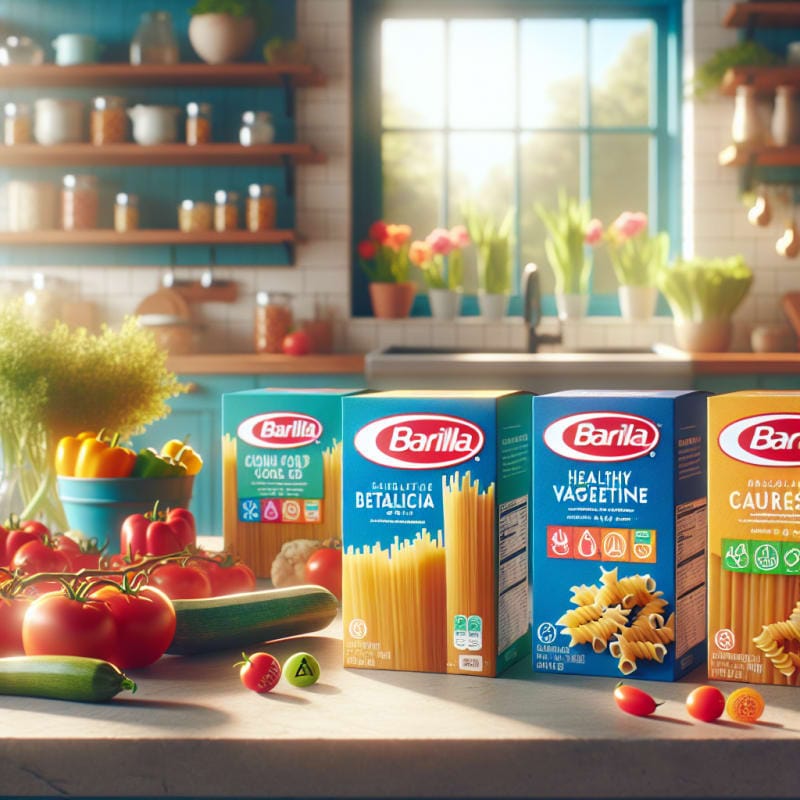Does Barilla Pasta Contain Allergens? A Comprehensive Guide for Lactose, FODMAP, and Allergy Concerns
Category: Lactose / FODMAP / Allergies
For millions of consumers worldwide, the simple act of choosing a box of pasta is more than a matter of taste—it is a question of health, safety, and informed decision-making. Food allergies, lactose intolerance, and FODMAP sensitivities have become increasingly prominent in public discourse, with the European Food Safety Authority (EFSA) estimating that up to 10% of Europeans have some form of food allergy[1]. In this context, the question does Barilla pasta contain allergens? is not just relevant—it is essential.
This article provides a detailed, evidence-based analysis of Barilla pasta’s allergen profile, referencing scientific research, regulatory guidelines, and the latest news. Whether you are a consumer with dietary restrictions or simply seeking greater awareness about what you eat, this guide will help you navigate the complexities of pasta ingredients and allergen risks.
Understanding Allergens in Packaged Foods
Allergens are substances that can trigger immune responses in sensitive individuals. The U.S. Food and Drug Administration (FDA) identifies eight major allergens: milk, eggs, fish, shellfish, tree nuts, peanuts, wheat, and soybeans[2]. In Europe, celery, mustard, sesame, lupin, and sulphites are also recognized[1].
- Lactose – A sugar found in milk, problematic for those with lactose intolerance.
- FODMAPs – Short-chain carbohydrates that can cause digestive issues in sensitive individuals.
- Gluten – A protein in wheat, rye, and barley; the primary concern for those with celiac disease or wheat allergy.
Packaged food manufacturers are required by law to declare the presence of these allergens. However, cross-contamination and ingredient changes mean vigilance is necessary.
Barilla Pasta: Ingredient Overview
Barilla is one of the world’s leading pasta brands, with products distributed in over 100 countries. Its classic pasta range typically contains two ingredients: durum wheat semolina and water. However, the company also offers specialty pastas, including gluten-free, whole grain, and protein-enriched varieties.
| Product | Main Ingredients | Potential Allergens |
|---|---|---|
| Classic (Blue Box) | Durum wheat semolina, water | Wheat (Gluten) |
| Whole Grain | Whole wheat flour, water | Wheat (Gluten) |
| Gluten-Free | Corn flour, rice flour | None (may contain traces of soy) |
| Protein+ Pasta | Durum wheat semolina, lentil flour, chickpea flour, pea protein | Wheat (Gluten), Legumes (Pea, Lentil, Chickpea) |
According to Barilla’s official allergen statement[3], their classic pasta contains only wheat and water, with no added eggs or milk. However, specialty lines may introduce other allergens, such as legumes or soy.
Does Barilla Pasta Contain Lactose?
Lactose intolerance affects approximately 65% of the global population, according to the National Institutes of Health[4]. For those avoiding lactose, Barilla’s classic pasta is generally safe, as it contains no dairy-derived ingredients. The company confirms that no milk or lactose is present in its traditional pasta range.
Q: Can people with lactose intolerance safely eat Barilla pasta?
A: Yes, Barilla’s classic and whole grain pastas are lactose-free. Always check specialty products for added ingredients.
Nonetheless, vigilance is advised for “Protein+” or “Ready Pasta” products, which may contain cheese or milk derivatives. Always review the ingredient list and allergen warnings.
Does Barilla Pasta Contain FODMAPs?
FODMAPs (Fermentable Oligo-, Di-, Mono-saccharides and Polyols) are carbohydrates that can trigger digestive symptoms in sensitive individuals, notably those with irritable bowel syndrome (IBS). Wheat is a high-FODMAP food, meaning traditional Barilla pasta is not low-FODMAP.
- Classic Barilla Pasta – Contains wheat; high in FODMAPs.
- Gluten-Free Barilla Pasta – Made from corn and rice; generally low-FODMAP.
For those following a low-FODMAP diet, Barilla’s gluten-free range is a safer choice. According to Monash University, corn and rice-based pastas are suitable for low-FODMAP diets[5].
Does Barilla Pasta Contain Other Allergens?
Beyond wheat and gluten, Barilla pasta is generally free from other major allergens. The classic range does not contain eggs, milk, soy, or nuts. However, cross-contamination can occur during manufacturing. Barilla states that their facilities follow strict allergen control protocols, but trace amounts may be present.
Q: Is Barilla pasta safe for people with nut or egg allergies?
A: Yes, Barilla’s classic pasta does not contain nuts or eggs. Always check packaging for cross-contamination warnings.
Specialty products, such as “Protein+” or “Veggie” pastas, may contain legumes or soy. Those with allergies to these ingredients should exercise caution.
Recent News: Allergen Labeling and Consumer Safety
As food allergies rise, regulatory bodies and manufacturers are under increasing pressure to improve transparency. In 2023, The New York Times reported on efforts to standardize allergen labeling, highlighting the importance of clear ingredient disclosure. Similarly, FoodNavigator covered new EU proposals to tighten food allergy warnings, reflecting growing consumer demand for safety.
Barilla has responded by updating its packaging and online resources to provide clearer allergen information. This aligns with FDA recommendations and helps consumers make safer choices[2].
How Food Scan Genius Empowers Allergy-Aware Consumers
For those with food sensitivities, manually checking every label can be tedious and error-prone. The Food Scan Genius app streamlines this process by allowing users to scan product barcodes and instantly view allergen information, ingredient breakdowns, and dietary compatibility.
- Instant alerts for allergens (milk, gluten, nuts, soy, etc.)
- FODMAP and lactose compatibility checks
- Personalized profiles for multiple sensitivities
- Regular updates based on manufacturer changes
User Testimonial: “Food Scan Genius has made shopping so much easier. I scanned a box of Barilla pasta and immediately saw it was safe for my lactose intolerance. Highly recommended for anyone with allergies!” – Maria, London
Download Food Scan Genius to take control of your dietary choices and avoid hidden allergens.
Broader Implications: Why Ingredient Awareness Matters
Barilla pasta’s allergen profile illustrates a larger issue: the increasing complexity of food ingredients and the importance of consumer awareness. With new products and formulations entering the market, the risk of accidental exposure to allergens rises. This is not limited to pasta—bread, sauces, snacks, and even beverages may contain hidden allergens or FODMAPs.
For those with severe allergies, even trace amounts can trigger life-threatening reactions. As such, ingredient transparency is not merely a regulatory requirement—it is a public health imperative. The FDA and EFSA continue to update guidelines, but consumers must remain vigilant.
Technology, such as Food Scan Genius, and ongoing education are vital tools in this landscape. They empower individuals to make informed choices, reduce anxiety, and improve quality of life.
Frequently Asked Questions
Is Barilla pasta gluten-free?
Most Barilla pasta contains gluten, as it is made from wheat. Barilla offers a gluten-free range made from corn and rice flour for those with celiac disease or gluten sensitivity.
Does Barilla pasta contain eggs?
No, Barilla’s classic pasta does not contain eggs. Specialty products may vary, so always check the label.
Can people with nut allergies eat Barilla pasta?
Barilla’s classic pasta does not contain nuts. However, cross-contamination is possible. Always review packaging for allergen warnings.
Is Barilla pasta suitable for a low-FODMAP diet?
Classic Barilla pasta is high-FODMAP due to wheat. The gluten-free range is generally low-FODMAP and suitable for sensitive individuals.
How can I check for allergens in Barilla pasta?
Read the ingredient list and allergen statement on the packaging. For added convenience, use the Food Scan Genius app to scan products and receive instant allergen alerts.
{
“@context”: “https://schema.org”,
“@type”: “FAQPage”,
“mainEntity”: [
{
“@type”: “Question”,
“name”: “Is Barilla pasta gluten-free?”,
“acceptedAnswer”: {
“@type”: “Answer”,
“text”: “Most Barilla pasta contains gluten, as it is made from wheat. Barilla offers a gluten-free range made from corn and rice flour for those with celiac disease or gluten sensitivity.”
}
},
{
“@type”: “Question”,
“name”: “Does Barilla pasta contain eggs?”,
“acceptedAnswer”: {
“@type”: “Answer”,
“text”: “No, Barilla’s classic pasta does not contain eggs. Specialty products may vary, so always check the label.”
}
},
{
“@type”: “Question”,
“name”: “Can people with nut allergies eat Barilla pasta?”,
“acceptedAnswer”: {
“@type”: “Answer”,
“text”: “Barilla’s classic pasta does not contain nuts. However, cross-contamination is possible. Always review packaging for allergen warnings.”
}
},
{
“@type”: “Question”,
“name”: “Is Barilla pasta suitable for a low-FODMAP diet?”,
“acceptedAnswer”: {
“@type”: “Answer”,
“text”: “Classic Barilla pasta is high-FODMAP due to wheat. The gluten-free range is generally low-FODMAP and suitable for sensitive individuals.”
}
},
{
“@type”: “Question”,
“name”: “How can I check for allergens in Barilla pasta?”,
“acceptedAnswer”: {
“@type”: “Answer”,
“text”: “Read the ingredient list and allergen statement on the packaging. For added convenience, use the Food Scan Genius app to scan products and receive instant allergen alerts.”
}
}
]
}
Conclusion: Making Informed Choices
In an era of rising food allergies and dietary sensitivities, the question does Barilla pasta contain allergens? is emblematic of a broader consumer challenge. While Barilla’s classic pasta is free from lactose, eggs, and nuts, it does contain wheat and gluten—key allergens for many. Specialty products may introduce additional risks, making ingredient awareness and label reading essential.
Scientific research, regulatory updates, and technological innovations are converging to help consumers make safer choices. By understanding ingredient lists, monitoring news, and leveraging tools like Food Scan Genius, individuals can minimize risks and enjoy their meals with confidence.
Ultimately, the responsibility for allergen safety is shared—between manufacturers, regulators, and consumers. By staying informed and proactive, we can all contribute to a safer, more transparent food system.





